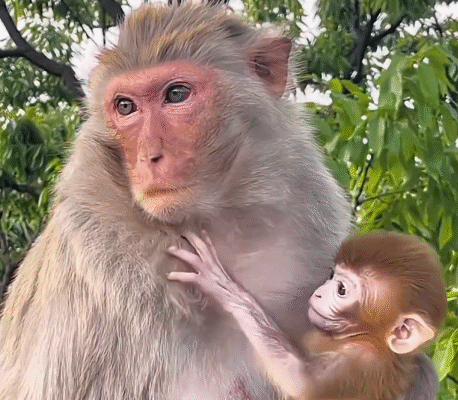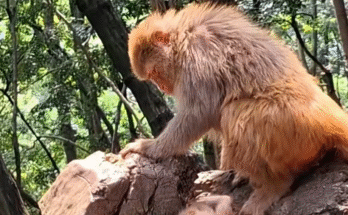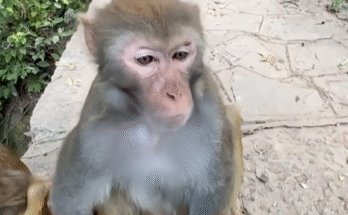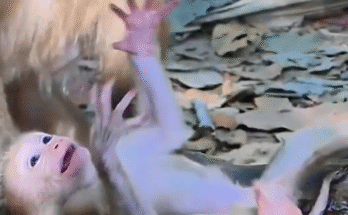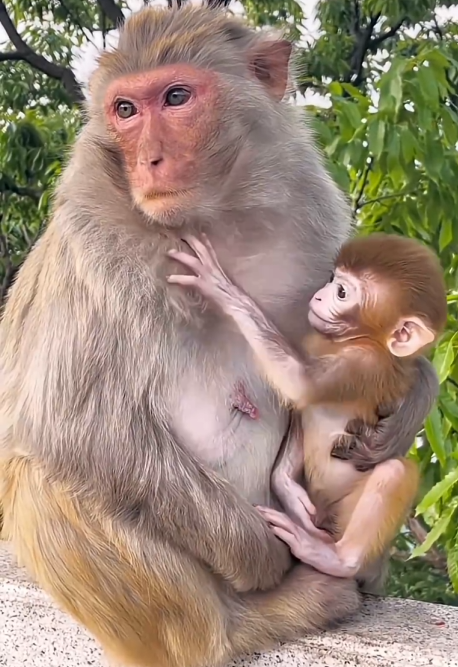
The words echoed through the forest clearing like a frustrated whisper carried by the wind: “How stupid. Males have nothing to do with rearing the young. They will kill them sometimes, though.” They weren’t spoken by anyone in the story itself, but by a wildlife researcher standing behind her camera, watching a heartbreaking event unfold right before her eyes.
She wasn’t insulting nature. She wasn’t mocking the animals. She was expressing the raw, stunned disbelief that so often comes with documenting wildlife—the moments when instincts clash with human emotion, when the rules of survival don’t align with what our hearts want to see.
And the story that inspired her words was unfolding around a troop of langur monkeys clinging to branches high above the ground.
The Troop and the New Male
The troop had always been stable—led by an older, experienced male who protected the group from rival troops. Around him lived several females and their young, all moving together like a well-practiced orchestra. But that peace ended the moment a strange, young male approached with the clear intention of taking over.
In the animal kingdom, especially among species like langurs, a new male overthrowing the leader isn’t rare. When it happens, the entire troop shifts. Females panic. Infants cling to their mothers. Every monkey becomes alert, watching the power struggle unfolding in chilling silence.
The old male tried to defend the troop, but age was not on his side anymore. He fought bravely, teeth flashing, fur flying, the clash echoing through the trees. But the younger rival eventually overpowered him. Defeated, the old leader limped away, his era ended in a single afternoon.
The researcher watching knew what would likely happen next. But knowing didn’t make witnessing it any easier.
Brutal Instincts and Impossible Emotions
In species like langurs, lions, and some primates, new males often kill infants that are not their own. It is nature’s cruel strategy—forcing the mothers back into reproductive condition so the new male can father his own offspring.
The new male approached the females one by one. Mothers screamed, clutching their babies to their chests, climbing higher, jumping further, desperate to put space between themselves and the danger.
The researcher whispered again, voice trembling:
“Males don’t help raise the young. They have nothing to do with it. And sometimes… they kill them.”
Her heart wanted to intervene. Her mind knew she couldn’t.
This was not malice.
This was not evil.
This was biology—ancient behavior shaped through evolution.
Still, for anyone watching, it was agonizing.
A Mother’s Fight

One mother in particular, a smaller female named Lani (as the researcher had called her), displayed a ferocity rarely seen. She had always been gentle, even shy, but now she was a warrior. Her baby clung to her belly, tiny fingers gripping her fur as tightly as his little muscles allowed.
The new male lunged toward her. Lani screamed, leaped across branches, and dodged him with lightning-fast reflexes. She had never moved like that before. Motherhood had sharpened her instincts; adrenaline had turned fear into power.
Other females cried out in warning, creating a chorus of fear around the treetops. The new male chased Lani viciously, determined to finish what instinct commanded.
But Lani never stopped fighting. She swung wide arcs through the canopy, jumped distances she had never dared before, even tried to hide among dense leaves. But the male kept tracking her, refusing to give up.
For hours the chase continued, each minute draining Lani’s strength, each leap shaking the tiny baby clinging to her body.
The Breaking Point
As daylight began to fade, Lani made one final desperate jump—one that was too far, too dangerous, too exhausting for her trembling muscles.
She slipped.
Her body hit a lower branch with a thud. The baby squealed in terror.
The new male seized that moment.
Before Lani could regain her footing, he snatched the infant away.
The mother’s scream ripped through the forest—a sound filled with grief, fury, helplessness. She attacked him, grabbing his fur, biting his arms, but the male was stronger, larger, and fueled by instinct.
The baby didn’t survive.
The forest fell painfully silent.
The researcher lowered her camera, wiping tears she had no shame in shedding.
“How stupid,” she whispered again, but this time her voice was softer—not an insult, but a human reaction to an inescapably tragic law of nature.
“So much pain… and for what? Just instinct.”
Lani curled into a ball on a branch, rocking gently, her arms wrapped around the baby who no longer moved. Other females approached her, offering comfort in the way primates do—touching her fur, staying close, sharing her grief. These moments, at least, reflected a kind of compassion humans could understand.
Acceptance Comes Slowly
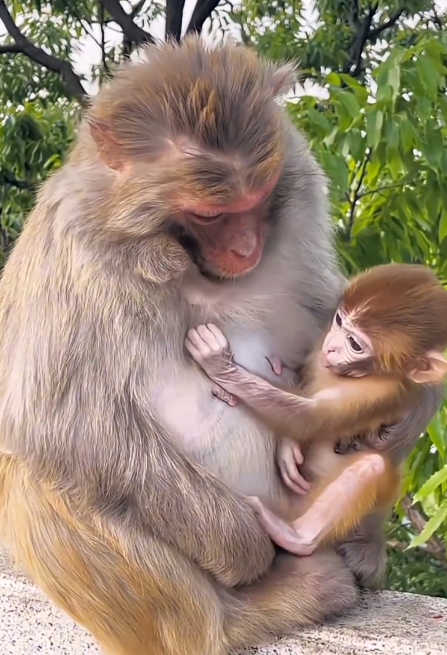
Over the next few days, Lani barely ate. She stayed isolated, mourning. The new male, having completed what evolution demanded, showed no interest in harming the females anymore. Soon, he began guarding the troop, acting as protector—his behavior suddenly shifting from aggression to stability.
The disturbing contradiction was hard for human hearts to swallow.
But that is nature:
Beautiful, cruel, magnificent, heartbreaking—always beyond human morality.
Eventually, Lani rejoined the troop. Life in the wild allows no pause, no mourning period long enough to heal fully. Food must be found. Safety must be maintained. Survival waits for no one.
Months later, Lani entered estrus again. The new male mated with her, and in time, she became pregnant.
And when her next baby was born, she held it with the same tenderness, the same fierce love, the same instinctual devotion that all mothers in nature possess. But this time, the baby was his, and therefore safe.
The cycle continued—nature’s rules unchanged.
A Human Lesson Hidden in the Wild
The researcher wrote in her journal that night:
“Instinct may be brutal, but it is not stupid. What is stupid is assuming nature should behave according to human emotion. Still… it hurts to watch.”
The truth is simple:
- Male animals in many species do not rear the young.
- Some will kill offspring from previous males.
- It is not cruelty—it is survival strategy.
- And yet, it remains one of the most painful behaviors to witness.
This story, like many in the natural world, reminds us that understanding nature doesn’t mean we must stop feeling for it. We can learn, observe, and respect—even when our hearts ache at what we see.
Because every creature, from Lani to the new male, is simply doing what millions of years have shaped them to do.
And there is nothing stupid about nature.
Only complicated.
Only raw.
Only real.
